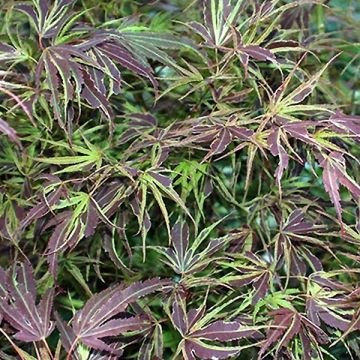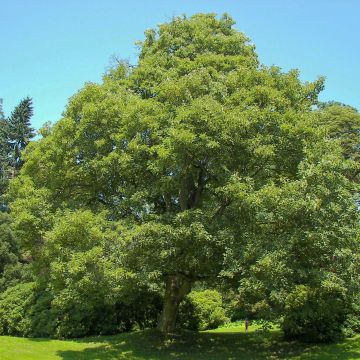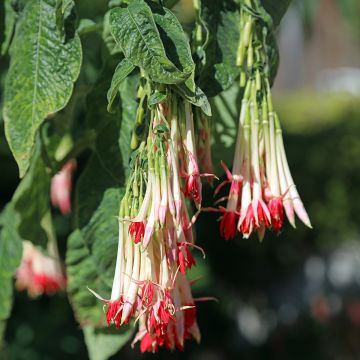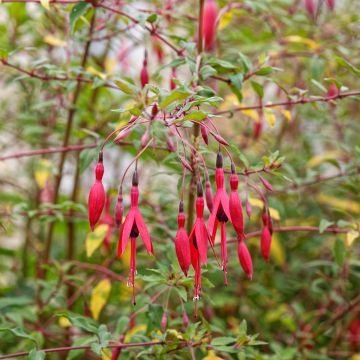

Acer pseudoplatanus Pruhonice - Sycamore Maple
Acer pseudoplatanus Pruhonice - Sycamore Maple
Acer pseudoplatanus Pruhonice
Sycamore, Sycamore maple, Planetree maple
Special offer!
Receive a €20 voucher for any order over €90 (excluding delivery costs, credit notes, and plastic-free options)!
1- Add your favorite plants to your cart.
2- Once you have reached €90, confirm your order (you can even choose the delivery date!).
3- As soon as your order is shipped, you will receive an email containing your voucher code, valid for 3 months (90 days).
Your voucher is unique and can only be used once, for any order with a minimum value of €20, excluding delivery costs.
Can be combined with other current offers, non-divisible and non-refundable.
Why not try an alternative variety in stock?
View all →This plant carries a 24 months recovery warranty
More information
We guarantee the quality of our plants for a full growing cycle, and will replace at our expense any plant that fails to recover under normal climatic and planting conditions.
Would this plant suit my garden?
Set up your Plantfit profile →
Description
Acer pseudoplatanus 'Pruhonice' is a variety of Sycamore Maple characterised by an oval, slender crown and beautiful foliage that changes colour. Its young leaves are yellow, sometimes pink, then they turn green to yellowish-green, with a red underside. In autumn, it turns golden yellow, orange, and red before falling. A beautiful deciduous shade tree, suitable for large gardens.
Acer pseudoplatanus 'Pruhonice' is a cultivar of Sycamore Maple named after the place where it was selected, the park of Průhonice Castle in the Czech Republic. Acer pseudoplatanus, not to be confused with Acer platanoides, is a tree native to mountainous regions of Europe that is known by various names depending on the region, including Sycamore Maple, False Plane Tree, Great Maple, or Mountain Maple, less commonly White Maple. It is a large forest tree of the Aceraceae family that can reach a height of 35 to 40 metres, often associated with fir and beech trees. This light and semi-shade tree can live up to 500 years. Its wood is commonly used for the production of musical instruments.
Acer pseudoplatanus 'Pruhonice' has a more oval than rounded canopy. It reaches a height of 16 to 20 metres and a spread of 7 to 8 metres at the age of 25. Its deciduous foliage is composed of large palmate, slightly rough leaves, divided into 5 deep lobes. They measure about 10-20 cm wide. The foliage colour may vary slightly depending on sun exposure. Generally, the young leaves are yellow to pink, then they turn slightly green while retaining a dark red underside. They take on fiery tones in autumn before falling. Flowering occurs in April-May, after the leaves have appeared. The small, greenish-yellow, nectar-rich flowers are arranged in pendulous terminal clusters. The fruiting, in the form of two-winged fruits called samaras, is abundant. It only appears on specimens aged at least 20 years. The bark of the branches is olive green to grey and flakes off in large plates as it ages.
The 'Pruhonice' Sycamore Maple will be highlighted when planted as a specimen tree or in a large grove. Its growth is suited to fairly spacious gardens. It is perfectly hardy and adapts to any soil that is sufficiently deep, rich, and not too dry. To accompany it in the garden, consider, for example, Hydrangea macrophylla, these semi-shade summer-flowering shrubs with large round inflorescences in pink, blue, or white, will contrast with the maple's foliage. You can plant spring bulbs such as daffodils, hyacinths, crocuses, and grape hyacinths at its base. They will bloom before the tree unfolds its foliage, bringing an early touch of colour to the garden.
Plant habit
Flowering
Foliage
Botanical data
Acer
pseudoplatanus
Pruhonice
Sapindaceae
Sycamore, Sycamore maple, Planetree maple
Cultivar or hybrid
Other Acer - Maple tree
View all →Planting and care
Acer pseudoplatanus 'Pruhonice' should be planted in spring or autumn in deep, slightly moist, preferably limestone-free soil, in a sunny location. It is perfectly hardy, however, strong winds can damage its beautiful foliage. Keep the soil moist during the first two summers after planting. Mulching can be beneficial to maintain soil moisture, depending on the climate. Pruning is not necessary. Remove dead wood in spring.
Canker is the main disease that affects maples.
Planting period
Intended location
Care
Planting & care advice
This item has not been reviewed yet - be the first to leave a review about it.
Similar products
Haven't found what you were looking for?
Hardiness is the lowest winter temperature a plant can endure without suffering serious damage or even dying. However, hardiness is affected by location (a sheltered area, such as a patio), protection (winter cover) and soil type (hardiness is improved by well-drained soil).

Photo Sharing Terms & Conditions
In order to encourage gardeners to interact and share their experiences, Promesse de fleurs offers various media enabling content to be uploaded onto its Site - in particular via the ‘Photo sharing’ module.
The User agrees to refrain from:
- Posting any content that is illegal, prejudicial, insulting, racist, inciteful to hatred, revisionist, contrary to public decency, that infringes on privacy or on the privacy rights of third parties, in particular the publicity rights of persons and goods, intellectual property rights, or the right to privacy.
- Submitting content on behalf of a third party;
- Impersonate the identity of a third party and/or publish any personal information about a third party;
In general, the User undertakes to refrain from any unethical behaviour.
All Content (in particular text, comments, files, images, photos, videos, creative works, etc.), which may be subject to property or intellectual property rights, image or other private rights, shall remain the property of the User, subject to the limited rights granted by the terms of the licence granted by Promesse de fleurs as stated below. Users are at liberty to publish or not to publish such Content on the Site, notably via the ‘Photo Sharing’ facility, and accept that this Content shall be made public and freely accessible, notably on the Internet.
Users further acknowledge, undertake to have ,and guarantee that they hold all necessary rights and permissions to publish such material on the Site, in particular with regard to the legislation in force pertaining to any privacy, property, intellectual property, image, or contractual rights, or rights of any other nature. By publishing such Content on the Site, Users acknowledge accepting full liability as publishers of the Content within the meaning of the law, and grant Promesse de fleurs, free of charge, an inclusive, worldwide licence for the said Content for the entire duration of its publication, including all reproduction, representation, up/downloading, displaying, performing, transmission, and storage rights.
Users also grant permission for their name to be linked to the Content and accept that this link may not always be made available.
By engaging in posting material, Users consent to their Content becoming automatically accessible on the Internet, in particular on other sites and/or blogs and/or web pages of the Promesse de fleurs site, including in particular social pages and the Promesse de fleurs catalogue.
Users may secure the removal of entrusted content free of charge by issuing a simple request via our contact form.
The flowering period indicated on our website applies to countries and regions located in USDA zone 8 (France, the United Kingdom, Ireland, the Netherlands, etc.)
It will vary according to where you live:
- In zones 9 to 10 (Italy, Spain, Greece, etc.), flowering will occur about 2 to 4 weeks earlier.
- In zones 6 to 7 (Germany, Poland, Slovenia, and lower mountainous regions), flowering will be delayed by 2 to 3 weeks.
- In zone 5 (Central Europe, Scandinavia), blooming will be delayed by 3 to 5 weeks.
In temperate climates, pruning of spring-flowering shrubs (forsythia, spireas, etc.) should be done just after flowering.
Pruning of summer-flowering shrubs (Indian Lilac, Perovskia, etc.) can be done in winter or spring.
In cold regions as well as with frost-sensitive plants, avoid pruning too early when severe frosts may still occur.
The planting period indicated on our website applies to countries and regions located in USDA zone 8 (France, United Kingdom, Ireland, Netherlands).
It will vary according to where you live:
- In Mediterranean zones (Marseille, Madrid, Milan, etc.), autumn and winter are the best planting periods.
- In continental zones (Strasbourg, Munich, Vienna, etc.), delay planting by 2 to 3 weeks in spring and bring it forward by 2 to 4 weeks in autumn.
- In mountainous regions (the Alps, Pyrenees, Carpathians, etc.), it is best to plant in late spring (May-June) or late summer (August-September).
The harvesting period indicated on our website applies to countries and regions in USDA zone 8 (France, England, Ireland, the Netherlands).
In colder areas (Scandinavia, Poland, Austria...) fruit and vegetable harvests are likely to be delayed by 3-4 weeks.
In warmer areas (Italy, Spain, Greece, etc.), harvesting will probably take place earlier, depending on weather conditions.
The sowing periods indicated on our website apply to countries and regions within USDA Zone 8 (France, UK, Ireland, Netherlands).
In colder areas (Scandinavia, Poland, Austria...), delay any outdoor sowing by 3-4 weeks, or sow under glass.
In warmer climes (Italy, Spain, Greece, etc.), bring outdoor sowing forward by a few weeks.



































































